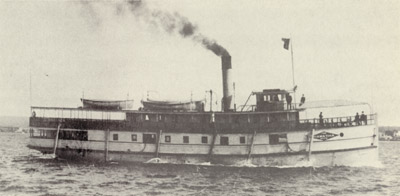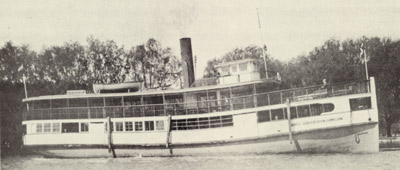Table of Contents
As a follow-up to our article in the March issue dealing with two of the large double-ended paddlers of the Toronto Ferry Company, we present here the story of one of the popular wooden single-ended propllers which operated in and around Toronto for many years and which also ventured far afield as her various owners tried to find a lucrative trade for her.
The hull which was eventually to become JASMINE was built in 1884 at Port Burwell, Ontario, and was named WILLIAM M. ALDERSON (Can. 73920) in honour of her owners. The builders gave the wooden steamer a length of 98 feet, a beam of 21 feet and a depth of 8 feet and her Gross Tonnage was shown as 122. Alderson operated his namesake, mostly in the Lake Erie excursion trade, until August 4, 1891, when she was severely damaged by fire at Port Dover, Ontario. Her upperworks were completely destroyed.
However, the ALDERSON's hull must still have been in reasonably good shape since it was towed to Toronto in the autumn of 1891, the ownership having passed to A. J. Tymon & Company, Toronto. The vessel was lengthened and rebuilt at the foot of Berkeley Street by George Dickson who, during the reconstruction, installed a new steeple compound engine built by Polson Iron Works Ltd. For their account, Polsons took back a mortgage on the boat. After the rebuild, the steamer measured 130.5 feet in length, 21.6 feet in the beam and 8.7 feet in depth. Her tonnage was listed as 194 Gross, 132 Net. She was reregistered at Toronto on July 7, 1892, as (b) A. J. TYMON (Can. 100038), being named in honour of "Andy" Tymon who operated ferries to Centre Island (then known as Island Park) across Toronto Bay.
The A. J. TYMON appears to have operated west from Toronto to Long Branch and Lorne Park, and across the lake to Grimsby and Jordan Harbour, the latter ports being on the south shore between Hamilton and Port Dalhousie. In 1894 she was commanded by Capt. J. J. Quinn and that year she operated on weekends for Alderman Thomas Davies to Victoria Park, a not overly successful amusement park and picnic grounds located east of downtown Toronto near the foot of what is now known as Victoria Park Avenue. This park was being promoted by Davies. When it is considered that passengers were carried from the Toronto waterfront to Victoria Park, a distance of more than five miles each way, for the grand sum of 25¢ return including park admission, it is evident that the uncertainties of local weather could make or break the most enterprising operator in a very short time. Nevertheless, in the 1890's day steamer rides to the various parks and beaches were one of the few public entertainments available, there being no automobiles, radio or television, and in many cases neither steam nor electric railways served these areas.
True to form, financial difficulties developed with the passing years and on March 2nd, 1903, Judge Thomas Hodgins in Admiralty Court turned over the shares of A.J. Tymon, James McSherry and John D. Murphy (the principals of A.J.Tymon & Company) to George Gooderham of Toronto. Mr. Gooderham was a member of the socially prominent family connected with the Gooderham and Worts distillery and also had an interest in the development of Lorne Park, located about fifteen miles west of Toronto.
Gooderham was successful in finding a buyer for the A. J. TYMON and on May 18, 1903, made a deal for the sale of the ship to George Thomas Marks of Port Arthur. Gooderham decided to hold the $4,000 mortgage himself. Marks took the TYMON to Sault Ste. Marie, Ontario, and on June 15, 1903, renamed her (c) OJIBWAY. He advertised her as operating on the "Hiawatha Route" between the Soo and the North Channel ports of Bruce Mines, Thessalon, and Blind River. The venture did not prove to be particularly successful but Marks did make enough money to pay off the Gooderham mortgage. When Marks sold OJIBWAY to Capt. Benjamin V. Naylor on May 7, 1906, he took back a mortgage himself for $4,700.

In her first year of service on "The Hiawatha Route", OJIBWAY was caught by the camera of A. E. Young at Sault Ste. Marie, 1903.
Capt. Naylor, who lived in Noyan, Quebec, thought that the steamer had a future in the Richelieu River trade and so in July 1906 he took her all the way down to Sorel where Telesphore Miseau refitted her. After the work, her dimensions were given as 112.4 x 21.91 x 7.4' and her tonnage as 298 Gross, 184 Net. Whether she was actually shortened by eighteen feet at this time is not clear. Possibly her length was now shown as "between perpendiculars" rather than "overall" as it may have been measured before. Certainly photos of the ship as OJIBWAY and those taken in later years when she served as a Toronto ferry do not indicate evidence of any major reconstruction, except for the removal of a cabin on the promenade deck. Perhaps the water she had been pushing had a shrinking effect!
Her new service did not last long, for on May 21st, 1907, the mortgagee, George Marks, died. The Executor of his estate, Toronto solicitor Hamilton Cassells, arranged for Capt. Naylor the sale whereby OJIBWAY was turned over to the Toronto Ferry Company Ltd. on March 27th, 1908. The steamer was reregistered at Toronto as (d) JASMINE and, in so naming her, the Toronto Ferry Company continued its practice of naming ferries after flowers. With the purchase, the ship was returned to Toronto where she had spent twelve of her earlier years.

JASMINE, showing her years, is seen preparing to leave Centre Island dock in 1927. Toronto Transportation Commission photo.
At the time of the purchase of JASMINE by the Toronto Ferry Company, one of the Toronto newspapers reported that the company had acquired the steamer ROTH which had previously operated at Noyan, Quebec, and that she would be converted to a double-ender in time for the 1909 season. It is not known whether Capt. Naylor had intended to rename OJIBWAY as RUTH or whether the article was referring to a completely different vessel which was never purchased. In any event, JASMINE remained a single-ender.
In her years with the Toronto Ferry Company, JASMINE was undoubtedly a more profitable venture for her owners than she had ever been before. She became a long-time favourite with both the summer residents of Centre Island (her normal route was to Centre) and the picnickers who thronged her decks. Familiarly referred to as "Jazz-mine" (those who knew her never pronounced her name as one normally does when speaking of the flower), she was commanded for many years by Capt. Osborne who also held an interest in the merry-go-round at Centre Island Park. He was succeeded by Capt. Tommy Bryan, JASMINE's last Skipper, whose close adherence to scheduled departure times frequently left tardy commuters fuming on the dock. Her engineer was named Jeffries. During the T. F. Co. years, the vessel was licensed for 400 passengers.
For those who do not know the location, the Centre Island dock lies in a sheltered but extremely restricted pond to which entry is gained by negotiating a turn in the narrow channel between Cannon Point on the west and Olympic Island to the east. JASMINE, once in, was too large a vessel to back out through the channel and then turn outside for the return trip to the city. To avoid stranding, she had to use a springline and pivot or warp around the end of the dock. This was a very interesting manoeuvre, although hard on the snubbing posts on ship and dock and even harder on the springline. It is said that on a quiet day, the sounds of this snubbing operation could be heard all the way to Ward's Island!
For twenty years, JASMINE sailed back and forth across the Bay, her low but very soft whistle announcing her comings and goings. The Toronto Ferry Company was formally taken over on November 1st, 1926, by the City of Toronto and when, on Feburary 21st, 1927, the Toronto Transportation Commission assumed control of operations from Mr. Lawrence Solman, JASMINE was included in the transfer. She was, however, nearing the end of her usefulness. Her hull had lost its good lines and had begun to hang down at the stern in addition to developing a rather alarming dip in the area of the funnel.
Despite her age, however, JASMINE operated through the 1927 season and in the Spring of 1928 was fitted out and given a fresh coat of paint. She did not run for many weeks in 1928 before the Government steamship inspectors paid her a visit in June. They obviously were more impressed by the tiredness of the old girl than by her new paint and accordingly she failed to pass muster, being refused a further certificate for operation. The T.T.C. promptly laid her up at Hanlan's Point and there she rested in retirement until August of 1929.
During these same years, there flourished on the shores of Humber Bay, west of the downtown area, a popular amusement park and beach known as Sunnyside Park and operated by the Toronto Harbour Commissioners. It seems that management of the operation employed a group of publicity men with pyromaniacal tendencies and on several occasions round about this time they decided that the burning of a ship in the lake off Sunnyside was just what was needed to bring the citizenry to the park in droves. Apparently they were right.
JASMINE, sold by the T.T.C. to the Toronto Harbour Commission, was towed to a spot inside the breakwater at Sunnyside and, on the evening of August 2nd, 1929, loaded with combustibles, was put to the torch as a spectacle suitable for the celebration of Civic Holiday. The poor old steamer provided the high point of the evening's entertainment as she burned to the water's edge. Several days later the remains of the hull were found floating in the lake and had to be removed. The Harbour Commission later dredged up the propeller and shaft which had sunk to the bottom of the lake and brought them into the harbour atop a barge. For some years they rested on the T.H.C. dock in the Keating Channel.
Over the years, other vessels were burned at the stake in the same manner. The small ferry JOHN HANLAN was the first to go and met her end on July 19, 1929, less than a month ahead of JASMINE. Another old ferry, CLARK BROS., went on June 30, 1930, and the schooners JULIA B. MERRILL and LYMAN M. DAVIS followed on July 1st (Dominion Day), 1931 and 1933, respectively. Thereafter, this barbaric custom, was mercifully discontinued.
And so in the flames died a gallant steamer that for forty-five years had wandered thousands of miles providing good times for her ever-loving passengers. JASMINE will long be remembered by Torontonians with a nostalgia feeling for those "good old days."
(Ye Ed. would like to extend special thanks to Jim Kidd for his help on JASMINE, and particularly for much technical data on the early years of the steamer. The photo of JASMINE at Centre Island was taken June 1st, 1927, and is reproduced through the courtesy of the Toronto Transit Commission.)
Previous Next
Return to Home Port or Toronto Marine Historical Society's Scanner
Reproduced for the Web with the permission of the Toronto Marine Historical Society.